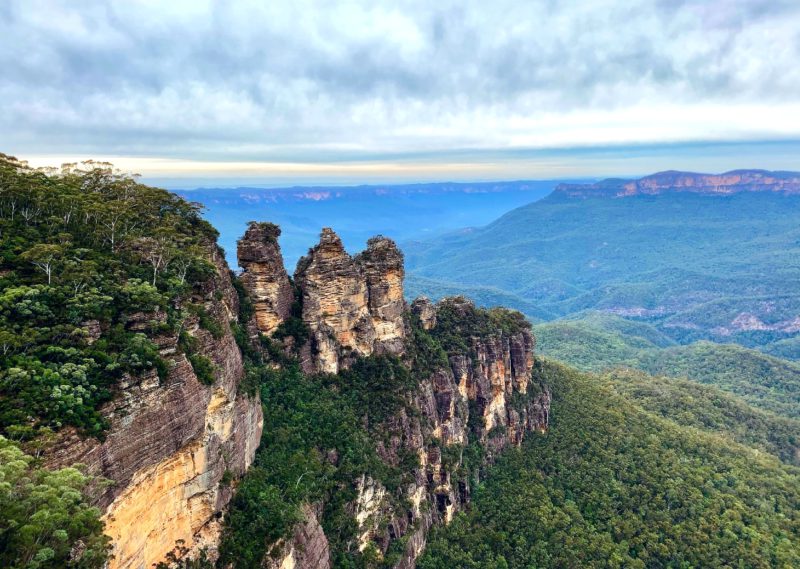The color blue is elusive in nature, but venture 90 minutes inland from Sydney’s city limits and you’ll discover the Blue Mountains, named for the blue haze blanketing the region’s peaks and valleys. Dense eucalyptus forests contribute to this incredible phenomenon, filling the atmosphere with fine oil vapors that mix with other particles in the air to scatter short wavelengths of blue light, giving the mountains a dreamy blue tint. Couple this with jaw-dropping natural wonders, caves, waterfalls, and scenic lookouts and you’ve got yourself an epic destination worth more than just a day trip. Here is our ultimate sightseeing guide for a perfect Blue Mountains overnight trip from Sydney, covering everything from what to do in the Blue Mountains to directions on how to get around.
About the Blue Mountains
The Blue Mountains are located in New South Wales, Australia. Bordering on Sydney’s metropolitan area, the region’s foothills start just 50 kilometers west of the city. The Blue Mountains are part of Australia’s most substantial mountain range, the Great Dividing Range, formed over 300 million years ago, stretching more than 3,500 kilometers along the Queensland, New South Wales, and Victorian coasts.
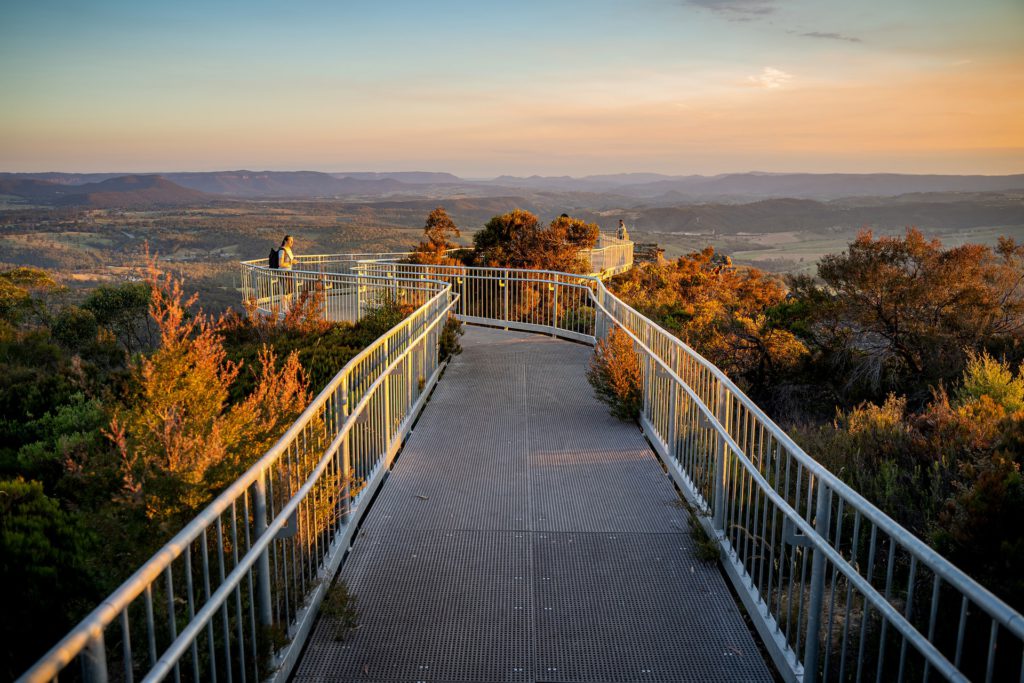
The region encompasses a series of mountain ridgelines separated by valleys up to 760 meters deep. The highest point in the Blue Mountains reaches an elevation of 1,189 meters. Scattered across the region at varying heights are several established towns, including Blackheath, Mount Victoria, Springwood, and the main town of the City of Blue Mountains, Katoomba.
The Blue Mountains is also part of the 1.03-million-hectare Greater Blue Mountains Area, one of the six UNESCO World Heritage Sites in New South Wales. The area is home to over 400 different animal species, including rare and endemic marsupials like the long-nosed potoroo and the spotted-tailed quoll.
When to visit the Blue Mountains — weather and climate
The Blue Mountains can be visited all year round, though the temperatures are a little more extreme than in Sydney. Covering such a wide area, the temperature varies depending on elevation. In the upper mountains, the average temperature is around 5°C in winter and 18°C in summer, while the lower region has a warmer climate, averaging around 16°C in winter and 29° in summer. There is usually a big difference in nighttime and daytime temperatures, so be sure to pack extra layers of clothing on your overnight trip. Temperatures can dip below zero on clear nights.
Wet weather is more prevalent in summer. If you’re looking to avoid rainy days, the winter season between May and July is generally cool and dry. The upper mountains experience around five or six days of snowfall a year during the winter months.
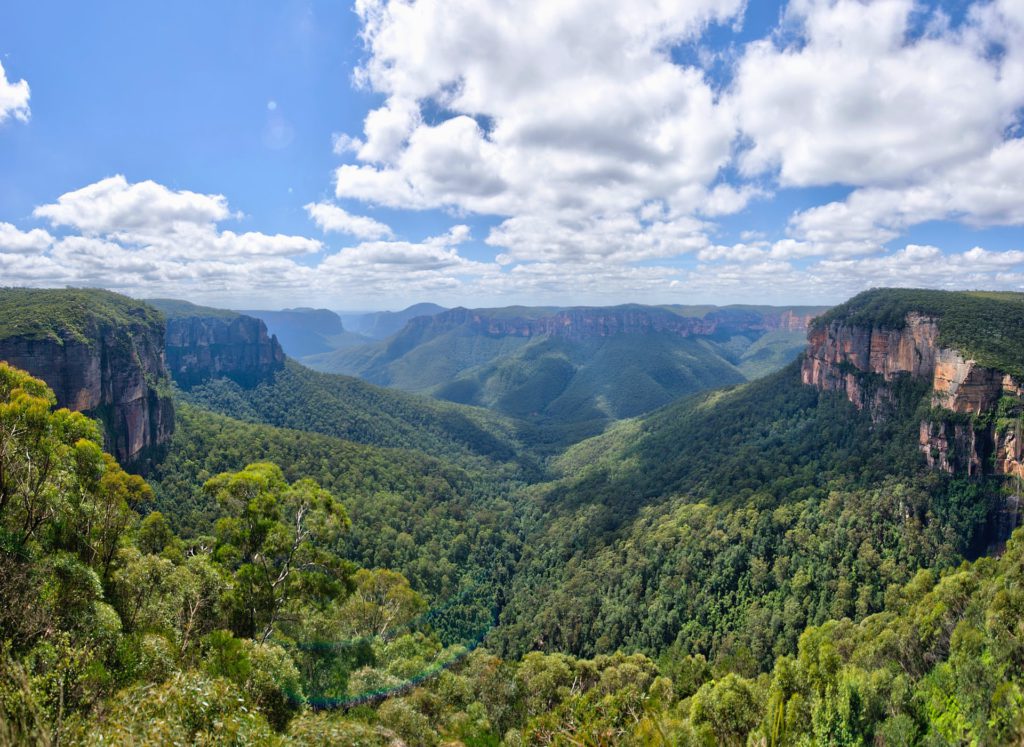
How to get to the Blue Mountains
The nearest major city to the Blue Mountains is Sydney. In light traffic, it is a 90-minute drive from Sydney’s city center to Katoomba. The journey is straightforward and well-signed, following the motorway and covering approximately 101 kilometers. Try to set off from the city as early as you can to avoid bad traffic.
Blue Mountains overnight sightseeing guide — 2-day itinerary
Route map
Day 1: Eagle Hawk Lookout – Scenic World – Katoomba Falls – Leura Cascades
Head to Eagle Hawk Lookout for epic views of the Three Sisters
At daybreak, start your journey towards the Blue Mountains — we recommend setting off early to beat the heavy traffic. The Blue Mountains are famous for incredible vistas and you will find plenty of lookouts on your journey. For your first taste of this, stop at Eagle Point Lookout, which commands breathtaking views of the Jamison Valley and, most importantly, the Blue Mountains’ group of iconic sandstone rocks: the Three Sisters.
This distinctive 200-million-year-old formation stands proud on a cliff that towers above the Jamison Valley. The tallest of the sisters is Meehni, standing at 922 meters. Wimlah and Gunnedoo are 918 meters and 906 meters respectively.
Traveler’s tip: Echo Point Lookout in Katoomba also offers the same sweeping view of the valley. However, the lookout is the most-visited attraction in the Blue Mountains and you’ll likely encounter busloads of tourists at this stop. Do yourself a favor on your self-drive trip and view the Three Sisters from the remote Eagle Point Lookout for zero crowds!
How to get to Eagle Hawk Lookout: Eagle Hawk Lookout is approximately 105 kilometers from Sydney’s city center. If traffic is light, it will take you 1.5 hours to reach the lookout, which you’ll find just down the road from Scenic World. There is a tiny car park at the lookout, visible from the road.
Admire Jamison Valley via Scenic World’s incredible railway, skyway, and cableway
Your next stop is Scenic World, the most popular man-made attraction in the Blue Mountains. Adventurers will delight in the three unparalleled ways to admire the Jamison Valley, each experience allowing you to see the valley from a different perspective. The Scenic Railway, originally built in the late 19th century to transport coal from the Katoomba coal mine, takes you on a thrilling 310-meter ride through a cliff tunnel and down to the valley floor on an incline of 52 degrees, making it the steepest passenger railway in the world. Alternatively, you can reach the bottom of the valley via the 545-meter Scenic Cableway in an enclosed cabin. This is the steepest aerial cable car in the Southern Hemisphere, granting riders unique views of the Three Sisters, Orphan Rock, and Mt. Solitary.
Finally, the Scenic Skyway allows you to enjoy grand views of the valley from a bird’s-eye view as you glide 720 meters between the cliff tops, suspended 270 meters above the landscape. See the Three Sisters and Katoomba Falls on your journey, and don’t forget to look down through the glass floor for awesome views of the ancient forest below!
Tickets for Scenic World experiences must be booked online — click here to plan your visit.
How to get to Scenic World: Follow directions for Violet Street and Cliff Drive, Katoomba, New South Wales 2780. It is located just two minutes north from the Eagle Hawk Lookout car park.
Hike to the beautiful Katoomba Falls
If you’re thinking of stretching your legs, it’s time for a hike! Hiking enthusiasts with a love for waterfalls, grottos, and ferns shouldn’t pass up the chance to hike to Katoomba Falls! Katoomba Falls is perhaps one of the most photographed waterfalls in all of Australia, being in close proximity to the Three Sisters. The waterfall stems from the Kedumba River and cascades 150 meters in two main segments. It is said to be the prettiest waterfall in the Blue Mountains.
How to get to Katoomba Falls: Set off from the main entrance of Scenic World (follow signs for the Prince Henry Cliff Walk). The 1.2-kilometer return track will take about two hours to complete, reaching an elevation of 146 meters. You will encounter some steep steps midway, but you don’t have to complete the entire track to come across views of Katoomba Falls should you feel like taking it easy — there are many lookouts along the way that also offer great views.
Get lost in nature along the Leura Cascades Trail
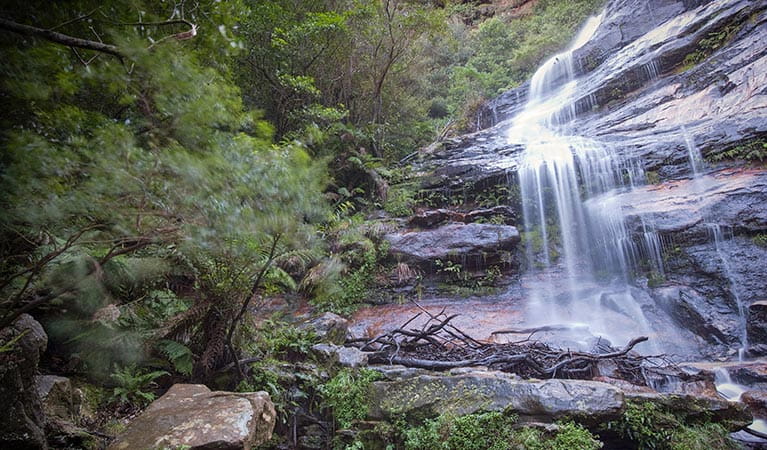
For a more moderate track, follow Leura Creek down to a charming waterfall on one of the loveliest short walks in the Leura area, located east of Katoomba. This circuit track allows you to admire the many small cascades in the park — take a walk beside the Leura Falls Creek rapids and make your way down to Leura Falls, crossing bridges along the way. Several other walking trails can be accessed from the Leura Cascades starting point, including the Prince Henry Cliff Walk.
The Leura Cascades circuit itself is an easy 844 meters and covers an elevation of about 62 meters. It will take you about 30 minutes to complete, with the highlight of the walk being a beautiful lookout right at the end with superb views of the valley.
How to get to the Leura Cascades Trail: Head to the Leura Cascades picnic area and car park, which are located along Chelmsford Drive in Leura. The start of the walking track is found at the southern end of the Leura Cascades picnic area, near the cave-like shelters.
Spend the night at woodsy-chic lodgings at Love Cabins
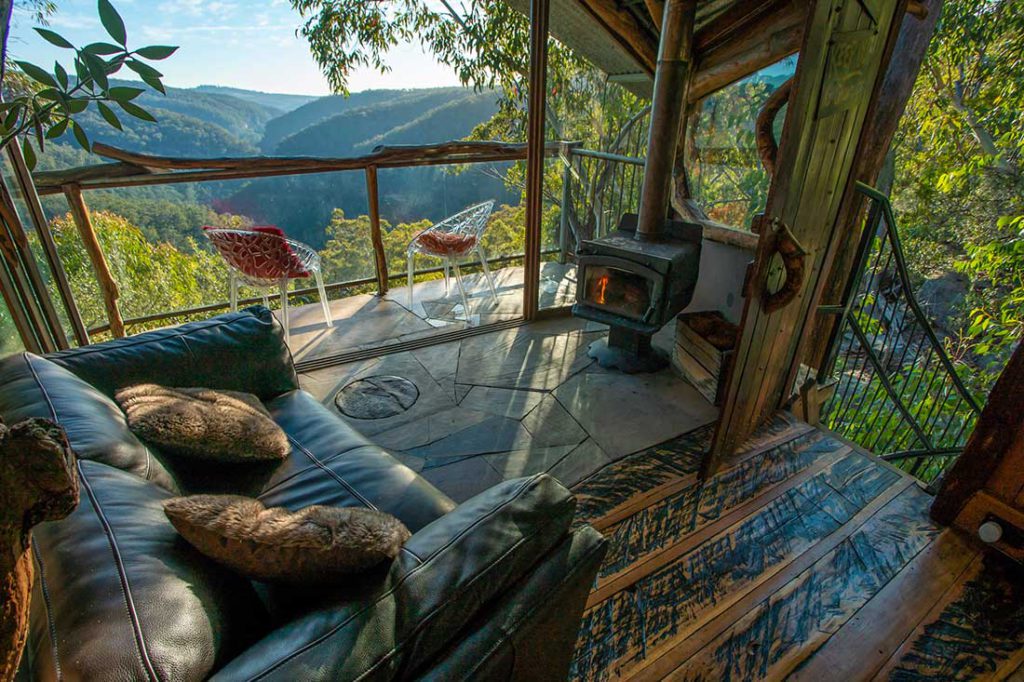
Before evening arrives, settle into the most romantic of all Blue Mountains escapes. Love Cabins and its collection of award-winning, beautifully-designed bush cabins take seclusion and privacy to a whole new level. Nestled amidst 600 acres of the bushland, you’ll find no better place to spend the night, cocooned in the ancient Blue Mountains forest. From one-of-a-kind treehouses fitted with luxurious comforts (think fireplace, kitchenette, queen bed, and floor-to-ceiling windows), to dreamy wooden cabins that blend into the natural surroundings, a stay with Love Cabins is an experience quite unlike anything else.
How to get to Love Cabins: Love Cabins is located approximately 53 kilometers from Leura — about a 50-minute drive. Follow directions to 17 Berambing Crest, Berambing NSW 2758.
Day 2: Jenolan Caves – Kanangra Walls – Govetts Leap Lookout & Pulpit Rock Lookout
Explore the ancient and awe-inspiring Jenolan Caves
Adventure-seekers, it’s time to venture into the depths of some of the oldest caves on earth. The Jenolan Caves are an attraction built around a collection of 11 impressive limestone caves located west of the Blue Mountains in the Jenolan Karst Conservation Reserve in the Central Tablelands region. Dating back hundreds of millions of years, they are the oldest discovered open caves in the world, the network following the course of a subterranean section of the Jenolan River and spanning over 40 kilometers of multi-level passages.
Take a guided tour through the network to see ancient fossilized remains found throughout. These insightful excursions are offered at different difficulties for different fitness levels.
Guided tours must be booked in advance — click here to plan your visit.
How to get to the Jenolan Caves: From Love Cabins, travel 90 kilometers southwest — about 1.5 hours by car. Pass the Blue Mountains Botanic Garden along Bells Line of Road, turn left onto Darling Causeway, and turn right onto the Great Western Highway. Continue onto Jenolan Caves Road and keep driving until you reach your destination.
Marvel at the sheer cliff face of the iconic Kanangra Walls
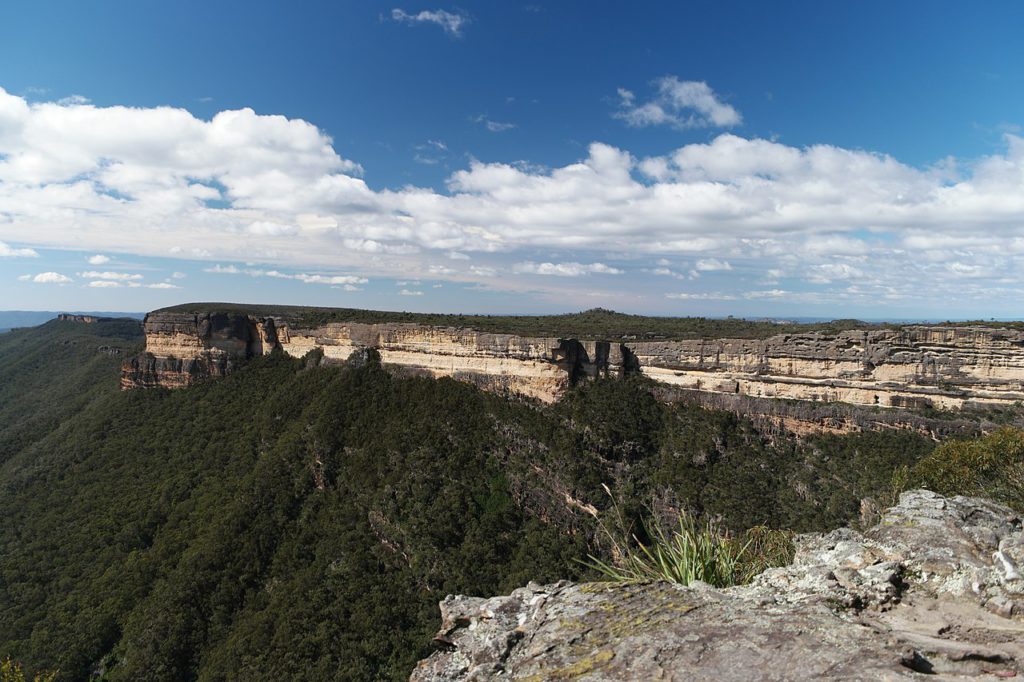
Hopefully, you still have enough space on your camera to take more photographs — there’s another spectacular sight to come. Leave the caves behind and journey south. Your next stop takes you deeper into the Greater Blue Mountains area to the 68,000-hectare Kanangra-Boyd National Park, where you’ll find the famous Kanangra-Boyd Lookout and unbelievable panoramic views of the Greater Blue Mountains World Heritage Area.
This unfenced lookout is a 10-minute walk down a track from the car park. From this vantage point, you’ll be able to enjoy superb views stretching from Kanangra Deep to the towering cliffs of the Kanangra Walls. Don’t forget to look up into the sky, too! You may be able to spot wedge-tail eagles soaring overhead.
Not convinced of the grandeur? Take a virtual tour of Kanangra-Boyd Lookout captured with Google Street View Trekker for a taste.
How to get to the Kanangra-Boyd Lookout: From Jenolan Caves, follow Jenolan Caves Road for 5.1 kilometers, then turn left onto Kanangra Walls Road. Head south for about 27 kilometers until you reach the car park to the lookout.
Stop at Govetts Leap Lookout and Pulpit Rock Lookout on the way back
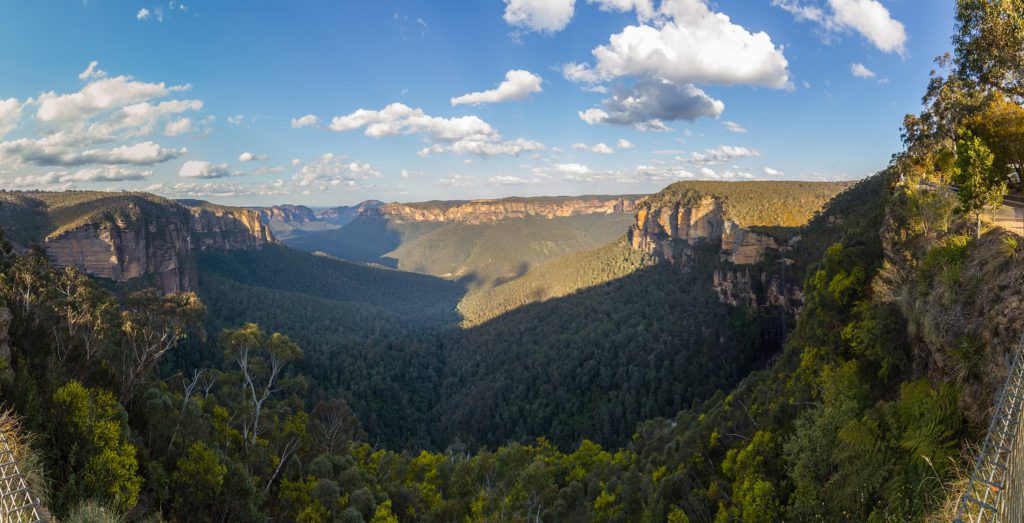
It’s time to head back to Sydney. Backtrack towards Katoomba, stopping about two kilometers east of Blackheath at Govetts Leap Lookout for a different view of the wilderness. From here, it’s all about unbeatable views of Grose Valley and the spectacular Bridal Veil Falls that plunges 180 meters down the side of the impressive cliff face.
For a different view of Grose Valley, head to the Pulpit Rock Lookout, located 15 minutes from Govetts Leap Lookout. This lookout takes full advantage of the massive rocky headland that it sits on, offering visitors not just one tier but three, at varying levels, from which you can properly admire the valley. Best of all, you can access it all for free!
Head back to Sydney using the same route you took to get to the Blue Mountains.
We hope we’ve given you plenty of inspiration on what to do in the Blue Mountains in two days!
About TourHero
TourHero is a social travel platform that enables you to travel with like-minded people and fall in love with the journey. We work closely with handpicked local operators to ensure every experience curated is unique and exclusive to your travel group. Come with us on epic adventures and create memories that last a lifetime!
